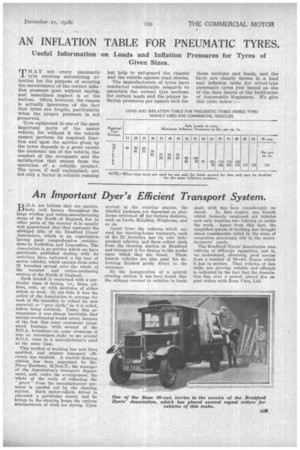An Important Dyer's Efficient Transport System.
Page 13

If you've noticed an error in this article please click here to report it so we can fix it.
B.D.A. are initials that are particularly well known throughout the large woollen and cotton-manufacturing areas of the North of England, but in other parts of the country it is equally well appreciated that they represent the abridged title of the Bradford Dyers' Association, which is an organizaton having most comprehensive ramifications in Yorkshire and Lancashire. The Association is, as articles which we have previously published dealing with its activities have indicated, a big user of motor vehicles, which operate from some 21 branches spread over the whole of the worsted and cotton-producing centres of the North of England.
Each branch is concerned with a particular class of dyeing, i.e., blues, yellows, reds, or with mixtures of either cotton or wool. At one time it was the policy of the Association to arrange for each of the branches to collect its raw material, or " grey cloth," as it is called, before being coloured. Tinder this arrangement it was almost inevitable that certain overlapping would occur, because of the fact that some customers transacted business with several of the B.D.A. branches—on some occasions it was no uncommon sight to see several B.D.A. vans in a manufacturer's yard at the same time.
This method of working has now been modified, and greater transport efficiency has resulted. A central clearing station has been organized by Mr. Percy Beethara, lietInst.T., the manager of the Association's transport department, and, under the arrangement, the whole of the work of collecting the "
greys" from the manufacturers' premises is carried out by the clearing. station. Each motor-vehicle driver is allocated a particular round, and he brings to the clearing house the various consignments of cloth for dyeing. Upon
arrival at the clearing station, the labelled packages are deposited on platforms sectioned off for various districts, such as Leeds, Keighley, Brighouse, and
SO On.
Apart from the vehicles which are used for clearing-house transport, each of the 21 branches has its own independent vehicles, and these collect cloth from the clearing station at Bradford and transport it for dyeing to the works upon which they are based. These branch vehicles are also used for delivering finished goods direct to the customer.
By the inauguration of a central clearing station it has been found that the milene covered in relation to loads dealt with has been considerably re duced. In this respect one branch which formerly employed six vehicles now only requires two vehicles to tackle the work. Apart from this fact, the simplified system of working has brought about considerable relief in the state of congestion previously rife in the manufacturers' yards.
The Bradford Dyers' Association uses vehicles of different capacities, and is, we understand, obtaining good service from a number of 80-cwt. Beans which it has in service, That Vehicles of this make are proving reliable and efficient is indicated by the fact that the Association has, over a period, placed five repeat orders with Bean Cars, Ltd.






























